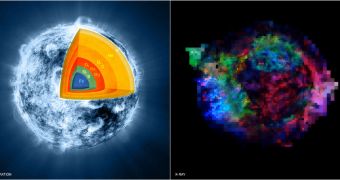Investigators studying the supernova remnant Cassiopeia A say that an analysis of the distribution of chemical elements within the structure suggests that the massive precursor star that spawned the remnant was turned inside out by the huge blast.
To reach this conclusion, researchers first had to map the distribution of chemicals within the remnant very thoroughly. They used the NASA Chandra X-ray Observatory (CXO) for this research.
With the new discovery, it may be possible to shed additional light on how supernovae occur. There are two main types of stellar explosions, one caused by instabilities within the core of massive stars, and one caused by the excessive accretion of mass from companions, in binary systems.
In this image, the left panel shows the precursor star as it would have looked like just centuries following the massive explosion. The cutaway indicates the approximate layered distribution of chemical elements within the star, coded for colors.
The iron at the core is depicted in blue, silicon and sulfur above in green, and a layer of magnesium, neon and oxygen in red. The three outer layers are made up of oxygen and carbon, helium and hydrogen, respectively.
In the right panel, we see a map of Cassiopeia A as it looks now. Experts behind the CXO study used the exact same color scheme – minus most of the hydrogen and helium – to map the distribution of chemicals within the cloud.
It's interesting to note the large accumulation of iron in the central-left part of the image, as well as the high amounts of silicon and sulfur enveloping most of the remnant. Its core is made up of neon, magnesium and atomic oxygen.
Neither Chandra, nor the NASA Spitzer Space Telescope was able to determine the existence of iron at the core of the supernova remnant. What this implies is that the star was literally turned inside out at the moment of the huge blast.
Supernovae are very powerful events. During the explosions, a star can emit more light than an entire galaxy, briefly outshining it as seen from our telescopes.
In the latest study of the remnant, large clumps of solid iron were discovered scattered throughout the structure, suggesting that the heavy element was produced through nuclear fusion, at the core of the star.
Details of the study were presented in the February 20 issue of The Astrophysical Journal.

 14 DAY TRIAL //
14 DAY TRIAL //